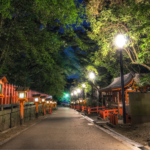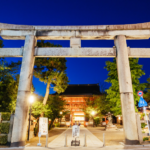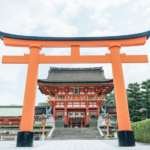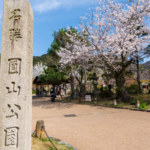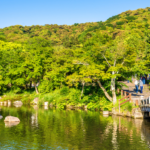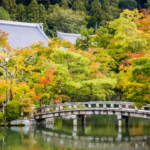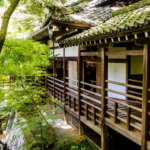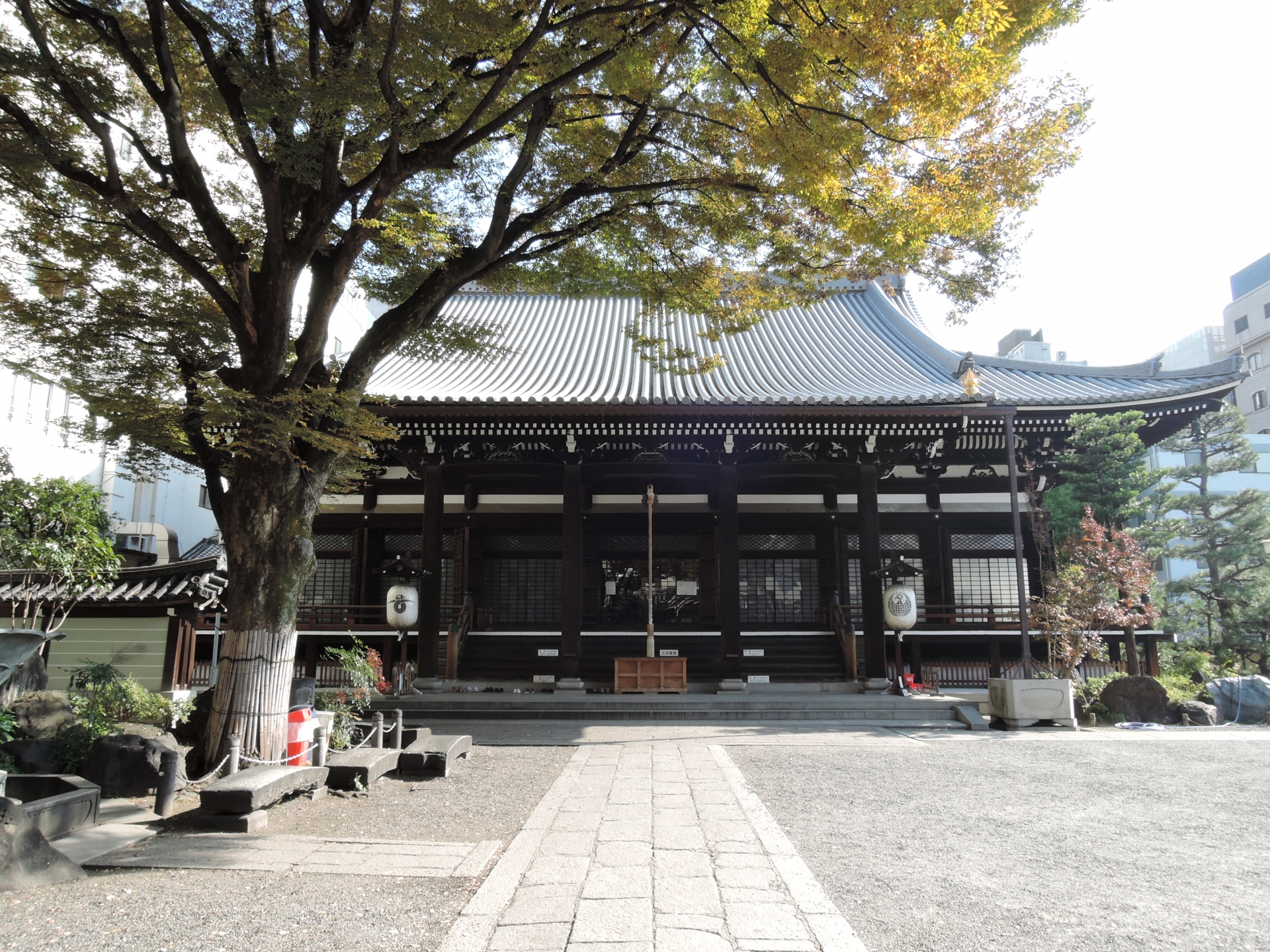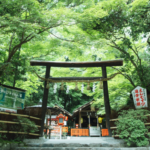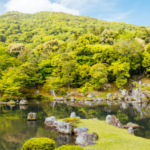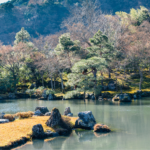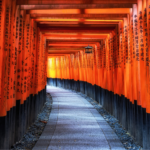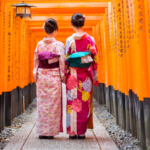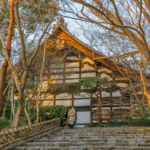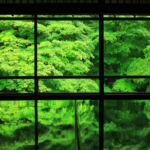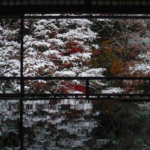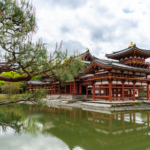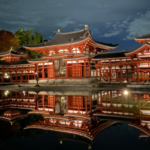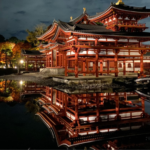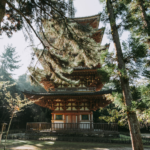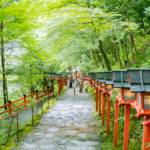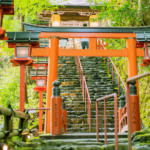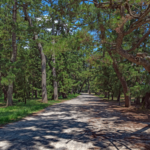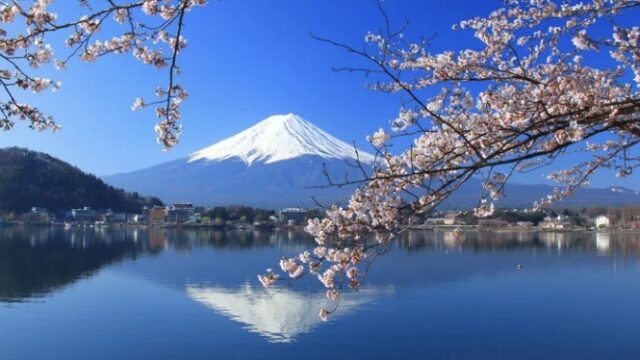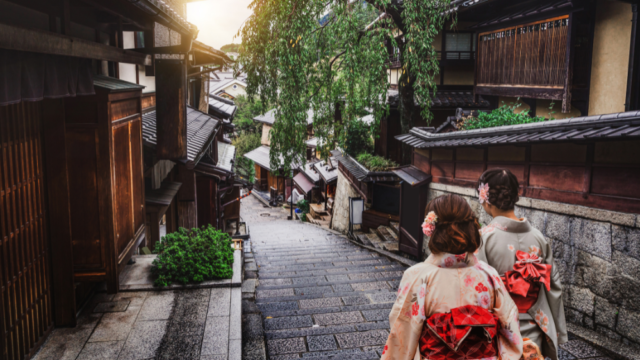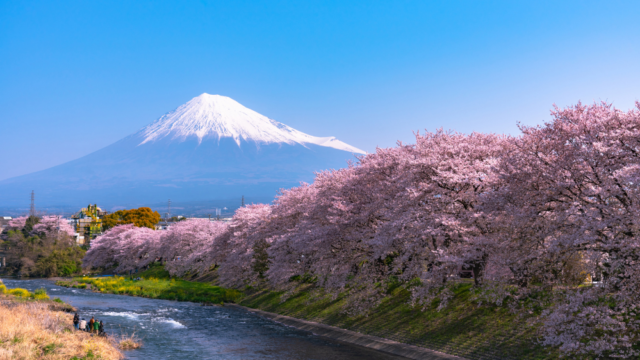Kyoto is a city where Japan’s history and culture are deeply rooted. It is home to numerous traditional temples, shrines, and gardens, each with over a thousand years of history. The cityscape harmonizes with the beautiful scenery of each season, offering new discoveries and inspiration every time you visit.
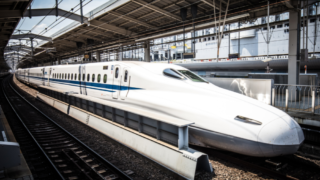
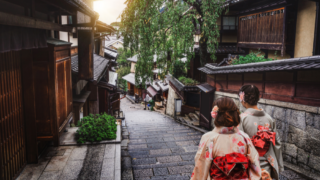
Kiyomizu-temple
 Kiyomizu-temple
Kiyomizu-temple
Kiyomizu-dera, founded in 778 by the monk Enchin, is one of Japan’s most famous temples and a top tourist attraction. The temple is particularly renowned for its main hall, which stands on a steep hillside and features a wooden stage that juts out 13 meters above the ground. This stage, constructed without the use of any nails, employs a technique known as “Kakezukuri.” The breathtaking view from this stage gave rise to the Japanese expression “to leap off the stage at Kiyomizu,” which means to take the plunge or to take a bold action.
Highlights:
- Main Hall and Stage: The wooden architecture, built without nails, is awe-inspiring and offers a stunning panoramic view of Kyoto, especially beautiful during the cherry blossom season in spring and the autumn foliage.
- Otowa Waterfall: Located within the temple grounds, the waterfall’s water is believed to confer academic success, romantic fulfillment, and longevity. Visitors drink from one of three streams, each stream offering a different benefit.
- Jishu Shrine: This shrine within the temple complex is dedicated to the deity of love and matchmaking, making it particularly popular among young people. The love fortune stones are famous, with visitors attempting to walk between them with their eyes closed to see if their love will be realized.
- Three-storied Pagoda: This pagoda is designated an Important Cultural Property and stands as a beautiful architectural piece attracting many visitors.
- Seasonal Scenery: The temple is renowned for its seasonal beauty, with cherry blossoms in spring and vibrant autumn leaves. The evening illuminations during these seasons provide a magical and different perspective of the temple grounds .
Best Seasons and Times to Visit An early morning visit is recommended to avoid the crowds and enjoy the tranquility. Evening illuminations offer a unique and enchanting experience. Nearby traditional streets such as Ninenzaka and Sannenzaka also offer a glimpse into historical Kyoto and are worth exploring.
Kiyomizu-dera is easily accessible, being about a 15-minute bus ride from Kyoto Station, followed by a 10-minute walk from the nearest bus stop. This beautiful temple, where history and nature blend harmoniously, is a must-visit to experience Japan’s traditional culture.
Yasaka Shrine
 Yasaka Shrine
Yasaka Shrine
Maruyama Park
 Maruyama Park
Maruyama Park
Maruyama Park, adjacent to Yasaka Shrine, is the oldest public park in Kyoto, established in 1886. This park is especially famous for its cherry blossoms, attracting numerous visitors each spring.
Highlights:
- Gion Weeping Cherry Tree (Shidarezakura): The centerpiece of the park, this iconic weeping cherry tree is a major attraction, especially during the cherry blossom season in early April. The tree is beautifully illuminated at night, providing a magical atmosphere.
- Cherry Blossoms (Hanami): The park boasts over 680 cherry trees, including varieties like Somei Yoshino and Yamazakura. The best time for viewing is from late March to early April. During this season, the park is filled with visitors enjoying flower-viewing parties (hanami).
- Night Viewing (Yozakura): Maruyama Park is a popular spot for night viewing of cherry blossoms, with light-ups extending until 1 AM during the peak season. The illuminated cherry blossoms create a breathtaking sight.
- Traditional Japanese Garden: Designed by the renowned gardener Ogawa Jihei, the garden features ponds, streams, and walking paths, offering a serene environment for leisurely strolls. The garden is beautiful year-round, with vibrant foliage in autumn and lush greenery in summer.
- Cultural Significance: The park also includes historical elements like the Chorakukan Villa, built by the tobacco magnate Murai Kichibee, which now serves as a hotel. Statues and monuments throughout the park reflect its rich cultural heritage.
Best Seasons and Times to Visit Spring is the most popular season for visiting Maruyama Park due to the cherry blossoms. The peak viewing period is late March to early April, but some cherry trees start blooming from mid-March. Autumn is also a beautiful time to visit, with the colorful leaves providing a picturesque backdrop for a pleasant walk.
Accessibility Maruyama Park is easily accessible, located just a short walk from Gion-Shijo Station on the Keihan Line or a 20-minute bus ride from Kyoto Station. The park is open 24 hours a day, and entry is free.
Eikando
 Eikando
Eikando
Eikando, formally known as Zenrin-ji, was established in 853. It is the head temple of the Seizan branch of Jodo Buddhism and is particularly renowned for its autumn foliage.
Highlights:
- Mikaeri Amida Statue: The principal image of Amida Buddha at Eikando is famous for its unique pose, looking back over its shoulder. According to legend, this statue once spoke to the monk Eikan, prompting him to look back.
- Tahoto Pagoda: This two-story pagoda, rebuilt in 1928, stands on a hill within the temple grounds. The view from the pagoda, especially during the autumn foliage season, is breathtaking and offers a panoramic view of Kyoto.
- Hojo Pond: Located at the center of the temple grounds, this pond reflects the stunning autumn colors. A small Benten shrine sits on an island in the pond, adding to the picturesque scenery.
- Covered Walkways: Wooden corridors connect the temple buildings, allowing visitors to enjoy the beautiful garden views as they stroll through the temple grounds. The autumn colors enhance the beauty of these walkways.
- Night Illuminations: During the autumn season, the temple grounds are illuminated at night, providing a magical and enchanting atmosphere different from the daytime experience.
Best Seasons and Times to Visit Eikando can be enjoyed throughout the year, but the best time to visit is during the autumn foliage season from mid to late November. Early mornings and weekdays are recommended to avoid the crowds and to fully appreciate the serene environment.
Accessibility Eikando is located in the Sakyo Ward of Kyoto, about a 15-minute walk from Keage Station on the Tozai Subway Line. It is also easily accessible by bus.
Eikando Temple offers a rich blend of historical significance and natural beauty, making it a must-visit destination for anyone exploring Kyoto.
Nanzen-ji Temple
 Nanzen-ji Temple
Nanzen-ji Temple
Nanzen-ji Temple, established in 1291 by Emperor Kameyama, is one of the most important Zen temples in Japan and serves as the head temple of the Rinzai sect of Zen Buddhism. Located at the base of Kyoto’s Higashiyama mountains, the temple is renowned for its beautiful gardens and historic buildings.
Highlights:
- Sanmon Gate: This massive gate, built in 1628, stands 22 meters high and is one of Japan’s three great gates. It was constructed to commemorate those who died in the Siege of Osaka Castle. Visitors can climb to the top for a panoramic view of Kyoto, although the stairs are quite steep .
- Hojo (Abbot’s Quarters): The main building, designated as a National Treasure, features exquisite rock gardens and sliding-door paintings by the famous Kanō Tanyū. The gardens are particularly beautiful during the autumn foliage season .
- Suirokaku Aqueduct: This brick aqueduct, built in the Meiji period, is part of a canal system that connects Kyoto with Lake Biwa. It is a popular photo spot, especially when framed by autumn leaves .
- Nanzen-in Temple: One of the sub-temples of Nanzen-ji, Nanzen-in has a garden that dates back to the 14th century. The garden is especially beautiful in autumn, with a pond shaped like a dragon that adds to its charm .
- Konchi-in Temple: Another sub-temple, Konchi-in is known for its Toshogu Shrine and the beautiful gardens designed by the famous landscape architect Kobori Enshu. It was relocated to its present site in 1605 .
- Tea Room: Near the entrance of the temple complex, visitors can enjoy a traditional tea ceremony in a beautiful room overlooking a waterfall. This experience offers a serene break from sightseeing .
Best Seasons and Times to Visit The best time to visit Nanzen-ji Temple is during the autumn foliage season from mid-November to early December. Early mornings are recommended to avoid crowds, especially before 8 AM. The temple grounds offer a peaceful retreat with fewer visitors during these hours .
Accessibility Nanzen-ji Temple is located in Kyoto’s Sakyo Ward, a 10-minute walk from Keage Station on the Tozai Subway Line. It is also accessible by city bus, with stops nearby .
Honno-ji Temple
Honno-ji Temple, founded in 1415 by the priest Nichiryu, is the head temple of the Hokke Sect of Buddhism. It is widely known as the place where Oda Nobunaga, one of Japan’s most famous warlords, met his end in 1582 during the betrayal by Akechi Mitsuhide, an event known as the Honno-ji Incident. This historical event marked a significant turning point in Japanese history.
Highlights:
- Main Hall: The current main hall was rebuilt in 1928 and features architectural styles from the early Showa period. The temple grounds are free to enter, but admission to the Daibinden Treasure Hall is charged.
- Nobunaga’s Mausoleum: This mausoleum is dedicated to Oda Nobunaga. Every year on June 2nd, a memorial service called “Nobunaga-kouki” is held to honor his spirit.
- Three-legged Frog: The incense burner with a three-legged frog is believed to be a charm for fire prevention. Honno-ji has suffered several fires throughout its history, and this incense burner plays an important role in its spiritual protection.
- Fire-Prevention Ginkgo Tree: The ginkgo tree in the temple grounds is said to have prevented a fire during the Hamaguri Gate Incident. This tree is now a protected tree in Kyoto City.
- Daibinden Treasure Hall: This hall houses many historical artifacts related to Oda Nobunaga, including scrolls and tea utensils. Admission fees are 500 yen for adults, with discounts available for groups.
Best Seasons and Times to Visit: Honno-ji can be visited year-round, but it is particularly recommended during the cherry blossom season in spring and the autumn foliage season. Visiting early in the morning is ideal for a quieter experience. Special events such as “Nobunaga-kouki” on June 2nd and “Hojoue” on September 15th are also notable times to visit .
Honno-ji is conveniently located in central Kyoto, just a one-minute walk from Kyoto Shiyakusho-mae Station on the Tozai Subway Line. It also has parking facilities, making it accessible by car.
Arashiyama
 Arashiyama
Arashiyama
Arashiyama is a scenic district on the western outskirts of Kyoto, offering a blend of natural beauty, cultural sites, and historical landmarks. This area has been a popular destination since the Heian Period (794-1185) when nobles would enjoy its serene setting.
Highlights:
- Togetsukyo Bridge: Known as the “Moon Crossing Bridge,” this iconic landmark was originally built during the Heian Period and reconstructed in the 1930s. It spans the Katsura River and offers picturesque views, particularly stunning during the cherry blossom season in spring and the autumn foliage season. A riverside park adjacent to the bridge features dozens of cherry trees, enhancing the scenic beauty .
- Bamboo Groves: The famous bamboo forest paths provide a tranquil walking experience. The towering bamboo stalks create a serene environment, especially enchanting when the wind causes them to sway gently. This area is ideal for a peaceful stroll and offers numerous photo opportunities .
- Tenryuji Temple: Established in 1339 by Ashikaga Takauji, this Zen temple is a UNESCO World Heritage Site. It is renowned for its beautiful Sogenchi Teien garden, which was Japan’s first Special Historical Scenic Spot. The garden is stunning year-round, with each season offering unique beauty. The temple buildings, including the Dharma Hall and Abbot’s Quarters, are also notable attractions .
- Iwatayama Monkey Park: Located on Mt. Iwatayama, this park allows visitors to see over a hundred Japanese macaques in their natural habitat. The hike to the top provides not only a chance to interact with the monkeys but also offers breathtaking panoramic views of Kyoto .
- Sagano Scenic Railway: Also known as the Sagano Romantic Train, this sightseeing train runs along the Hozu River, offering a delightful journey through the scenic countryside. The open-air carriages provide an immersive experience of the surrounding nature, making it a popular activity during the autumn foliage season .
Best Seasons and Times to Visit Arashiyama is particularly popular during the cherry blossom season in early April and the autumn foliage season in late November. These periods offer the most striking views and are the best times to visit for scenic beauty. Early mornings or late afternoons are recommended to avoid crowds and enjoy a more peaceful experience .
Accessibility Arashiyama is easily accessible from central Kyoto. It is a short train ride from Kyoto Station to Saga-Arashiyama Station on the JR Sagano Line. Buses and rental bicycles are also available, making it convenient to explore the area and its numerous attractions.
Tenryu-ji Temple
 Tenryu-ji Temple
Tenryu-ji Temple
Tenryu-ji Temple, located in the Arashiyama district of Kyoto, was established in 1339 by the shogun Ashikaga Takauji. This Zen temple is the head temple of the Tenryu-ji branch of the Rinzai Zen sect and is a UNESCO World Heritage Site. It is a popular destination for its historical and cultural significance.
Highlights:
- Sogenchi Garden: Designed by the renowned landscape architect Muso Soseki, the garden is considered one of the finest examples of Japanese landscape design. It features a large central pond surrounded by rocks, pine trees, and the scenic Arashiyama mountains in the background, offering a stunning view throughout the seasons .
- Unryu-zu (Cloud Dragon Painting): This massive dragon painting on the ceiling of the Dharma Hall (Hatto) appears to stare down from any angle, a technique known as “happonirami” (eight-directional gaze). The dragon is a powerful symbol in Zen Buddhism, representing enlightenment.
- Hojo (Abbot’s Quarters): The main hall of the temple, designated as a National Treasure, houses exquisite sliding-door paintings and calligraphy scrolls, many of which are Important Cultural Properties. The hall’s serene interior is a testament to the refined aesthetics of Zen culture .
- Muso Soseki’s Garden Design: The gardens remain true to the original design by Muso Soseki, featuring a pond that reflects the surrounding landscape. This garden is especially beautiful in the autumn foliage and cherry blossom seasons.
- Sagano Scenic Railway: Near Tenryu-ji, the Sagano Scenic Railway offers a delightful ride through the beautiful countryside. This sightseeing train is especially popular during the autumn foliage season, providing breathtaking views of the changing leaves.
Best Seasons and Times to Visit Tenryu-ji is worth visiting year-round, but the most beautiful times are during the cherry blossom season in spring and the autumn foliage season. Early mornings and weekdays are recommended to avoid crowds and enjoy a more peaceful experience.
Accessibility Tenryu-ji is located in Kyoto’s Ukyo Ward, about a 13-minute walk from Saga-Arashiyama Station on the JR Sagano Line. It is also within walking distance from Arashiyama Station on the Keifuku Arashiyama Line, making it easily accessible by public transportation .
Fushimi Inari Taisha
 Fushimi Inari Taisha
Fushimi Inari Taisha
Fushimi Inari Taisha is the head shrine of approximately 30,000 Inari shrines across Japan, dedicated to Inari, the deity of rice, commerce, and business prosperity. Founded in 711, it is located in Fushimi Ward, Kyoto. The shrine is particularly famous for its “Senbon Torii” (thousands of red torii gates), attracting numerous visitors from both Japan and abroad.
Highlights:
- Senbon Torii: The iconic path lined with countless red torii gates is the symbol of Fushimi Inari Taisha. These gates are donated by worshippers and businesses, creating a path that stretches about 4 kilometers. Early morning or late afternoon visits are recommended for a quieter experience.
- Main Hall (Honden): The grand main hall, rebuilt during the Edo period, is designated as an Important Cultural Property. It draws numerous visitors, especially during the New Year, when the shrine is bustling with people).
- Otabisho: Located in central Kyoto, the Otabisho is where the mikoshi (portable shrines) rest during festivals. It plays a significant role during events like the Gion Matsuri, highlighting the shrine’s connection with the local community.
- Mt. Inari Trails: Behind the shrine lies Mt. Inari, dotted with numerous smaller shrines and stone markers. The hiking trail to the summit takes about two hours and offers scenic views of Kyoto along the way.
- Okusha Hohaisho: Located further along the Senbon Torii path, the inner shrine is particularly revered. Visitors can also try the “omokaruishi” (wish-granting stones), which are believed to indicate the fulfillment of wishes based on their perceived weight when lifted.
Best Seasons and Times to Visit Fushimi Inari Taisha is worth visiting year-round, but it is particularly beautiful during the cherry blossom season in spring and the autumn foliage season. Early morning or late afternoon visits are recommended to avoid crowds and enjoy a more peaceful experience.
Accessibility Fushimi Inari Taisha is easily accessible, located just a 5-minute walk from Inari Station on the JR Nara Line and a 5-minute walk from Fushimi Inari Station on the Keihan Line. It is also conveniently accessible by bus from central Kyoto.
Ryoan-ji Temple
 Ryoan-ji Temple
Ryoan-ji Temple
Ryoan-ji Temple, established in 1450 by Hosokawa Katsumoto, is a Zen temple belonging to the Myoshin-ji branch of the Rinzai sect. It is a UNESCO World Heritage Site and is particularly renowned for its famous rock garden (kare-sansui garden).
Highlights:
- Rock Garden: The most famous attraction at Ryoan-ji is its rock garden, which features 15 stones arranged in a sea of white sand. The design is such that no matter where you stand, you can never see all 15 stones at once. This layout symbolizes “imperfect beauty” and offers various interpretations to visitors .
- Hojo (Abbot’s Quarters): The Hojo, the main building for viewing the rock garden, is designated as an Important Cultural Property. Inside, you can find sliding screen paintings and other artworks that embody the spirit of Zen.
- Chokushi-mon Gate: The Imperial Messenger’s Gate, located at the entrance to the Hojo, was once used by imperial and noble envoys. Its dignified appearance reflects its historical significance .
- Tsukubai: Near the tea room entrance, this stone basin is inscribed with the Zen phrase “Ware tada taru wo shiru” (I only know contentment), reminding visitors of the importance of humility and satisfaction.
- Kyoyochi Pond: This pond, located in the center of the garden, was a popular spot for boating among the aristocracy during the Heian period. The pond is surrounded by seasonal flowers that delight visitors throughout the year .
Best Seasons and Times to Visit Ryoan-ji is worth visiting year-round, but it is particularly beautiful during the cherry blossom season in spring and the autumn foliage season. Early morning visits are recommended for a quieter experience.
Accessibility Ryoan-ji Temple is a 10-minute walk from Ryoan-ji Station on the Keifuku Dentetsu Kitano Line, or a 7-minute walk from the Ritsumeikan University bus stop. It is about a 30-minute bus ride from Kyoto Station.
Rurikoin Temple
 Rurikoin Temple
Rurikoin Temple
Rurikoin Temple is a beautiful temple located in the Yase district of Sakyo Ward, Kyoto, renowned for its stunning autumn foliage. Originally built as a villa for Sanjo Sanetomi, it now serves as a Buddhist temple. The temple is open to the public only during special periods in spring and autumn, attracting many visitors.
Highlights:
- Garden of Ruri (Ruri no Niwa): The main garden of Rurikoin, designed to represent the Pure Land. The view from the second-floor study is spectacular, with the vibrant autumn leaves or fresh greenery reflecting on the table, attracting many photographers. The garden features moss and streams, creating a serene and tranquil atmosphere.
- Garyō no Niwa (The Reclining Dragon Garden): This garden symbolizes a dragon descending from the heavens to drink water. It features a stream flowing along a slope and a pond, with moss-covered ground creating a beautiful landscape.
- Sutra Copying Experience: The second floor of the study has low desks arranged for visitors to hand-copy Buddhist sutras. This activity offers a quiet, meditative experience.
- Kikakutei Tea House: Named by the Meiji-era statesman Sanjo Sanetomi, this tea house offers visitors the chance to enjoy tea while overlooking the beautiful garden.
- Seasonal Scenery: Rurikoin offers stunning views in all seasons, with cherry blossoms and fresh greenery in spring, lush green gardens in summer, and vibrant autumn leaves. The autumn foliage season, in particular, is highly recommended for its breathtaking beauty .
Best Seasons and Times to Visit Rurikoin Temple is open only during special viewing periods in spring and autumn. The autumn foliage season (October to December) is especially beautiful. Visiting early in the morning is recommended to avoid crowds and enjoy the tranquility.
Accessibility Rurikoin Temple is a 5-minute walk from Yase-Hieizanguchi Station on the Eizan Electric Railway. It can also be accessed by bus or taxi from central Kyoto.
Byodoin Phoenix Hall
 Byodoin Phoenix Hall
Byodoin Phoenix Hall
Byodo-in Temple, located in Uji, Kyoto Prefecture, is a historic Buddhist temple particularly known for its Phoenix Hall. Originally built as a villa for Fujiwara no Michinaga in 998, it was converted into a temple by his son, Fujiwara no Yorimichi, in 1052. Byodo-in was designated a UNESCO World Heritage Site in 1994, attracting many visitors each year.
Highlights:
- Phoenix Hall: The iconic main hall of Byodo-in, housing a statue of Amida Buddha created by the renowned 11th-century sculptor Jocho. The hall gets its name from the two phoenix statues on its roof. This building, along with the Amida Buddha statue, is designated as a National Treasure.
- Pure Land Garden: Surrounding the Phoenix Hall, this garden is a prime example of a Heian period Pure Land garden. The garden’s design, featuring a pond that reflects the hall, is meant to represent the Buddhist concept of paradise and is designated as a Historic Site and Place of Scenic Beauty.
- Kannon-do Hall: Another hall within the temple grounds that displays various Buddhist statues and paintings, most of which date back to the Heian period, highlighting their historical significance.
- Hoshokan Museum: Located near the Phoenix Hall, this museum exhibits numerous historical artifacts and cultural treasures associated with Byodo-in. The collection includes 52 wooden statues of Bodhisattvas on clouds, which are particularly noteworthy .
- Seasonal Scenery: Byodo-in is known for its stunning seasonal beauty, with cherry blossoms in spring, lush greenery in summer, vibrant foliage in autumn, and a serene snow-covered landscape in winter. The autumn foliage season, in particular, is a popular time to visit.
Best Seasons and Times to Visit Byodo-in Temple is worth visiting year-round, but it is especially beautiful during the cherry blossom season in spring and the autumn foliage season. Early morning or late afternoon visits are recommended to avoid crowds and enjoy a more peaceful experience.
Accessibility Byodo-in Temple is conveniently located about a 10-minute walk from either Uji Station on the JR Nara Line or Uji Station on the Keihan Uji Line. It is easily accessible by train or bus from central Kyoto.
Daigo-ji Temple
 Daigo-ji Temple
Daigo-ji Temple
Daigo-ji Temple, founded in 874 by the Buddhist monk Shobo (Rigen Daishi), is the head temple of the Daigo school of Shingon Buddhism. Located at the base of Mount Daigo in Fushimi Ward, Kyoto, it is a UNESCO World Heritage Site. The extensive grounds are divided into two areas: Upper Daigo (mountain area) and Lower Daigo (valley area), featuring numerous historical buildings and cultural assets.
Highlights:
- Sanboin (Abbot’s Quarters): Established in 1115, Sanboin was later reconstructed with the support of Toyotomi Hideyoshi in 1598. The garden of Sanboin is a prime example of Momoyama period garden design and is famous for the grand tea ceremony hosted by Hideyoshi. The main reception room offers a stunning view of the entire garden.
- Five-story Pagoda (Gojunoto): Completed in 951, this pagoda is one of the oldest wooden structures in Kyoto and is designated as a National Treasure. Standing approximately 38 meters tall, the first level of the pagoda features paintings of the mandala and the eight patriarchs of the Shingon sect.
- Main Hall (Kondo): Originally built in the late Heian period and later relocated to Daigo-ji by order of Toyotomi Hideyoshi, the Main Hall houses the Yakushi Nyorai (Medicine Buddha) statue. The hall itself is designated as a National Treasure.
- Reihokan Museum: This museum displays a vast collection of Daigo-ji’s historical artifacts and artworks, including statues and paintings from the Heian period, providing a glimpse into the temple’s rich history.
- Cherry Blossom Viewing: Known as “the temple of flowers,” Daigo-ji is famous for its cherry blossoms, particularly during the spring season when approximately 1,000 cherry trees bloom. The temple’s “Daigo no Hanami” (cherry blossom viewing party) was famously hosted by Toyotomi Hideyoshi, and a reenactment parade called “Hotaiko Hanami Gyoretsu” is held annually in April .
Best Seasons and Times to Visit Daigo-ji is worth visiting year-round, but it is particularly beautiful during the cherry blossom season in spring and the autumn foliage season. Early morning or weekday visits are recommended to avoid crowds and enjoy a more peaceful experience.
Accessibility Daigo-ji Temple is a 15-minute walk from Daigo Station on the Kyoto Municipal Subway Tozai Line. It is also accessible by Keihan Bus, about a 30-minute ride from Kyoto Station.
Kifune Shrine
 Kifune Shrine
Kifune Shrine
Kifune Shrine is a historic Shinto shrine located in the mountains of Sakyo Ward, Kyoto. It is dedicated to Tamayori-hime-no-mikoto, the goddess of water and rain. The shrine was established around 1,300 years ago and is surrounded by beautiful natural scenery, attracting many visitors.
Highlights:
- Stone Steps and Lanterns: One of the most striking features of Kifune Shrine is the stone stairway lined with red lanterns, leading up to the main hall. This pathway offers a different scenic view in each season, from the fresh greenery in spring to the deep green of summer, the vibrant autumn leaves, and the serene snow-covered landscape in winter.
- Water Fortune Telling (Mizu-ura-mikuji): The shrine is famous for its unique water fortune-telling. Visitors can dip a special paper into the shrine’s sacred water to reveal their fortunes, a popular ritual among visitors.
- Okumiya (Rear Shrine): Located further up the mountain, Okumiya is the original site of the main shrine. According to legend, Tamayori-hime arrived at this spot in a yellow boat. The site includes a large stone called “Funazuka,” believed to be where the goddess’s boat is buried.
- Nakamiya (Middle Shrine): Known for its blessings related to love and matchmaking, Nakamiya is where it is said that the deity Ninigi no Mikoto prayed for successful relationships. This spot attracts many visitors seeking blessings for their love lives.
- Kawadoko Dining: During the summer, restaurants along the Kibune River set up platforms called “kawadoko” above the water, offering a cool and refreshing dining experience. This traditional dining style is especially popular among tourists during the hot summer months.
Best Seasons and Times to Visit Kifune Shrine is worth visiting year-round, but it is especially beautiful during the summer for kawadoko dining and in autumn for the vibrant foliage. Early mornings and weekdays are recommended to avoid crowds and enjoy a peaceful visit.
Accessibility Kifune Shrine is approximately a 30-minute journey from central Kyoto via the Eizan Electric Railway, followed by a 20-minute walk from Kibuneguchi Station. There are also buses available from Kibuneguchi Station to the shrine, making it easily accessible by public transportation.
Amanohashidate
 Amanohashidate
Amanohashidate
Amanohashidate is one of Japan’s three scenic views, located in Miyazu City, Kyoto Prefecture. It is a natural sandbar covered with about 8,000 pine trees, stretching 3.6 kilometers across Miyazu Bay. The name “Amanohashidate” translates to “Bridge to Heaven,” as the sandbar appears like a pathway connecting the sky and the earth.
Highlights:
- Amanohashidate View Land: Located on the southern side of the sandbar, this viewpoint offers a panoramic view of Amanohashidate, referred to as “Hiryukan” or the view of a dragon flying in the sky. Visitors can take a monorail or lift to the top for a breathtaking view. The site also features attractions like a small amusement park and the popular “瓦投げ” (kawarake-nage), where visitors throw small clay discs for good luck.
- Kasamatsu Park: Situated on the northern side, this park also offers stunning views of Amanohashidate, particularly famous for the “matanozoki” viewing method, where one bends over and looks at the scenery upside down between their legs, making it appear as though the sandbar is floating in the sky.
- Chionji Temple: Located at the southern end of Amanohashidate, this temple is dedicated to Monju Bosatsu, the Buddhist deity of wisdom. It is a popular spot for students and scholars seeking blessings for academic success. The temple grounds feature unique ema (wooden prayer plaques) tied to pine trees.
- Nariaiji Temple: Found on the hillside overlooking Amanohashidate, Nariaiji Temple is the 28th temple on the Saigoku Kannon Pilgrimage. It is renowned for its beautiful gardens and panoramic views, especially during cherry blossom season in spring and autumn foliage season.
- Ine no Funaya: About 15 kilometers north of Amanohashidate, the fishing village of Ine is famous for its unique funaya (boat houses). These structures have boat garages on the first floor and living quarters above, creating a picturesque waterfront scene. Many funaya have been converted into guesthouses, offering visitors a unique overnight experience.
Best Seasons and Times to Visit Amanohashidate is beautiful year-round, but it is particularly stunning during the cherry blossom season in spring and the autumn foliage season. Early morning or late afternoon visits are recommended for a quieter and more serene experience.
Accessibility Amanohashidate is accessible from Kyoto by the JR Hashidate Limited Express, which takes about 2 hours. From Osaka, travelers can take the JR Konotori Limited Express to Fukuchiyama Station and transfer to the Kyoto Tango Railway, making the total journey about 2.5 hours. Alternatively, long-distance buses from major cities like Kyoto and Osaka provide a budget-friendly option.





